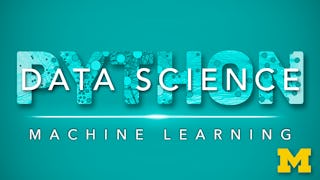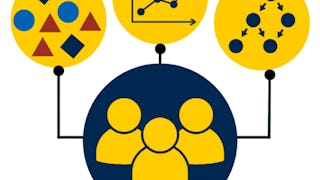In “Applied Unsupervised Learning in Python,” you will learn how to use algorithms to find interesting structure in datasets. You will practice applying, interpreting, and refining unsupervised machine learning models to solve a diverse set of problems on real-world datasets.

Get a Black Friday boost with $160 off 10,000+ programs.Save now.


Applied Unsupervised Learning in Python
This course is part of More Applied Data Science with Python Specialization

Instructor: Kevyn Collins-Thompson
Included with 
Recommended experience
What you'll learn
Apply unsupervised learning methods, such as dimensionality reduction, manifold learning, and density estimation, to transform and visualize data.
Understand, evaluate, optimize, and correctly apply clustering algorithms using hierarchical, partitioning, and density-based methods.
Use topic modeling to find important themes in text data and use word embeddings to analyze patterns in text data.
Manage missing data using supervised and unsupervised imputation methods, and use semi-supervised learning to work with partially-labeled datasets.
Skills you'll gain
Details to know

Add to your LinkedIn profile
June 2025
21 assignments
See how employees at top companies are mastering in-demand skills

Build your subject-matter expertise
- Learn new concepts from industry experts
- Gain a foundational understanding of a subject or tool
- Develop job-relevant skills with hands-on projects
- Earn a shareable career certificate

There are 4 modules in this course
Welcome to Module 1! In this module, we will learn the basic unsupervised learning methods that focus on transformation of data: dimensionality reduction, manifold learning, and density estimation. We will be using realistic datasets for our analyses, implemented using the scikit-learn library. At the end of this Module, our assignment is to apply Principal Components Analysis to gain insight into a large real-world dataset. We will use manifold learning methods such as t-SNE to visualize complex structure, and use kernel density estimation to estimate probabilities of conditional events. Let’s begin!
What's included
18 videos7 readings7 assignments1 programming assignment1 discussion prompt
Welcome to Module 2! In this module’s module, we will learn about clustering—another critical and widely-used unsupervised learning method. We will learn about the most important families of clustering algorithms, such as hierarchical methods (agglomerative bottom-up, divisive top-down), partitioning methods (k-means, k-medoids) and density-based methods (DBSCAN). We will also gain awareness of how to evaluate and optimize cluster quality. At the end of this module, our assignment is to apply a variety of these clustering approaches to realistic datasets using SciKit-Learn's clustering capabilities. Let’s begin!
What's included
10 videos3 readings5 assignments1 programming assignment
Welcome to Module 3! In this module’s module, we will learn about estimating latent variables—another important area of unsupervised learning, especially for text-based applications. We will focus first on the topic of text representations. Topic modeling is another form of latent variable estimation, which we will learn about via two different methods: Latent Dirichlet Allocation (LDA) and Non-Negative Matrix Factorization. We will also survey word embeddings to learn how to represent words with vectors in semantically useful ways. At the end of this module, our assignment is to solve problems through analyzing topic structure in a large document collection, and applying word embeddings to an NLP-related task. Let’s begin!
What's included
8 videos2 readings5 assignments1 programming assignment
Welcome to Module 4, our last module of the course! We wrap up our course by learning about how unsupervised methods can be integrated with supervised learning methods to improve prediction performance. A key topic this module in that direction covers imputation methods for dealing with missing data. We will also look at various special topics, including extensions of unsupervised learning that are used at the cutting edge of today's technology: semi-supervised learning and self-supervised learning. At the end of this module, our assignment is to apply methods and techniques for imputing missing data and semi-supervised learning, with the underlying theme being how unsupervised learning can improve supervised learning. Let’s begin!
What's included
7 videos3 readings4 assignments1 programming assignment
Earn a career certificate
Add this credential to your LinkedIn profile, resume, or CV. Share it on social media and in your performance review.
Instructor

Offered by
Explore more from Machine Learning
 Status: Free Trial
Status: Free TrialUniversity of Michigan
 Status: Free Trial
Status: Free Trial Status: Free Trial
Status: Free TrialUniversity of Michigan
Why people choose Coursera for their career





Open new doors with Coursera Plus
Unlimited access to 10,000+ world-class courses, hands-on projects, and job-ready certificate programs - all included in your subscription
Advance your career with an online degree
Earn a degree from world-class universities - 100% online
Join over 3,400 global companies that choose Coursera for Business
Upskill your employees to excel in the digital economy
Frequently asked questions
To access the course materials, assignments and to earn a Certificate, you will need to purchase the Certificate experience when you enroll in a course. You can try a Free Trial instead, or apply for Financial Aid. The course may offer 'Full Course, No Certificate' instead. This option lets you see all course materials, submit required assessments, and get a final grade. This also means that you will not be able to purchase a Certificate experience.
When you enroll in the course, you get access to all of the courses in the Specialization, and you earn a certificate when you complete the work. Your electronic Certificate will be added to your Accomplishments page - from there, you can print your Certificate or add it to your LinkedIn profile.
Yes. In select learning programs, you can apply for financial aid or a scholarship if you can’t afford the enrollment fee. If fin aid or scholarship is available for your learning program selection, you’ll find a link to apply on the description page.
More questions
Financial aid available,


